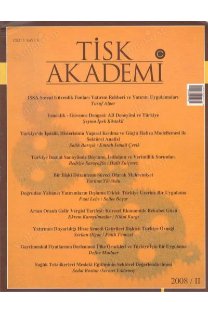Türkiye İmalat Sanayiinde Büyüme, İstihdam ve Verimlilik Sorunları
Growth, Employment and Productivity Problems in Turkish Manufacturing Industry
___
- Aaronson, D., E. R. Rissman ve P. G. Sullivan (Q2/2004), “Assesing the Jobless Recovery” Federal Reserve Bank of Chicago Economic Perspectives, Vol:28: pp:2-20.
- Arıcanlı, T. ve D. Rodrik, eds. (1990), The Political Economy of Turkey: Debt, Adjustment an Sustainability, London, Mc Millan Press.
- Ay, A. ve Z. Karaçor (2006), “2001 Sonrası Dönemde Türkiye Ekonomisinde Krizden Büyümeye Geçiş Üzerine Bir Tartışma”, Selçuk Üniversitesi Sosyal Bilimler Enstitüsü Dergisi, Sayı 16 : 67-68
- Bozdağlıoğlu, E.Y.U. (07.01.2008), “1990’dan Günümüze İşgücü Piyasası ve İstihdamı n Yapısal Analizi”, www.akademikbakis. org/sayi11/makale/bozdaglioglu.doc. , erişim: 12.01.2008.
- Dickey, D.A. ve W. Fuller (1981), “Likehood Ratio Statistics for Autoregressive Time Series with a Unit Root” Econometrica (49): 1057-1072.
- Döpke, J. (2001), “The Employment Intensity of Growth in Europe”, Kiel Institute of World Economics”, Kiel Working Paper, No: 1021.
- Ercan, H. (2006), İstihdamsız Büyüme: Verimlilik Artışı mı, Yeni İş Yasası mı? Bir Ön Değerlendirme, Türkiye Ekonomi Kurumu: 173-186., Ankara.
- European Comission (2002), Comminication From the Comisssion to The Council, Taking Stock of Five Years of the European Employment Strategy, Brussels.
- Findley, D.F., B.C. Monsell, W.R. Bell, M.C. Otto, B. Chen. (April 1998), “New Capabilities and Methods of the X-12-ARIMA Seasonal Adjustment Program”, Journal of Business and Economic Statistics, Vol.15, No. 2: 127-152.
- Fuller, W. (1976), Introduction to Statistical Time Series, New York: Wiley.
- Günçavdı, Ö. ve S. Küçükçiftçi. (2006), “Türkiye Ekonomisinde Büyümenin Kaynakları ve İstihdam Etkileri (1993-1998)”, Ekonomik Büyümenin Dinamikleri ve İstihdam, Türkiye Ekonomi Kurumu, Ankara : 196-200.
- Kara, M., Duruel, M. (2003), “Türkiye’de Ekonomik Büyümenin İstihdam Yaratamama Sorunu”, www.iibf.kou.edu.tr/ceko/ ssk/kitap50/19pdf (erişim: 07.01.2008): 367-394.
- Kaynak, M. (2007), “İşsizlik ve Emek Kalitesi” TİSK Akademi 2007 Özel Sayı 1, Ankara, s: 67
- Logeay. C., ve J. Volz. (2001), “EMU: Economic Growth Leads to Job Creation”, Economic Bulletin, Vol.38, No:2, DİW Berlin, s:50.
- MacKinnon J.G., (1991), Critical Values For Cointegration Tests. In R.F. Engle and C.W.J. Granger (eds), Long-Run Economic Relationships. Oxford: Oxford University Press: 267-276.
- Marx, K. (1990) Kapital 3. Cilt, Çeviren: Alaattin Bilgi, Onur Yayınları.
- Metin, K., ve fi. Üçdoğruk (1998), “Türk İmalat Sanayiinde Uzun Dönem Ücret-Fiyat-İ stihdam İlişkilerinin Ekonometrik Olarak İncelenmesi”, Çukurova Üniversitesi, İktisadi ve İdari Bilimler Fakültesi Dergisi, Cilt:8, Sayı:1.
- Nehru V. ve Dhareshwar, A. (1993), “A New Database on Physical Capital Stock: Sources, Methodology and Results”, Revista Analisis de Economico, 8 (1): 37-59.
- Newey, W. ve West, K. (1987a), “A Simple Positive Semi-Definite Heteroscedasticity and Autocorrelation Consistent Covariance Matrix”, Econometrica, (55): 703-708.
- Newey, W. ve West, K. (1987b), “Hypothesis Testing with Efficent Method of Moments Estimation”, International Economic Review (28): 777-778.
- Perron, P. (1989), “The Great Crash, The Oil Price Shock and The Unit Root Hypotesis”, Econometrica, Vol. 57, No. 6.
- Pulak, İ. (2008), İmalat Sanayiinde Ücret, Verimlilik, İstihdam ve Üretim İlişkisi, Uzmanlı k Tezi, MPM, Ankara.
- Saint-Paul, G. (2004), “Why Are European Countries Diverging in Their Unemployment Experiences”, Journal of Economic Perspectives, 18 (4).
- Saraçoğlu ve Suiçmez (2006), Türkiye İmalat Sanayinde Verimlilik, Teknolojik Gelişme, Yapısal Özellikler ve 2001 Krizi Sonrası Reel Değişimler, MPP Yayını.
- Taymaz, ve H. Suiçmez (2005), Türkiye’de Verimlilik ve Kriz, MPM Yayını, Ankara.
- Terzi, H. ve S. Oltulular (2004), “Türkiye’de Sanayileşme ve Ekonomik Büyüme Arasındaki Nedensel İlişki” Doğuş Üniversitesi Dergisi.
- TÜİK Verileri. www.tuik.gov.tr erişim tarihi; 28,3,2008
- Türkiye Kalkınma Bankası (TKB) (2007), Türkiye’de İmalat Sanayinin Yapısal Analizi ve Sektörel Performans Değerlendirmesi, Ankara.
- TÜSİAD (Haziran 2005), “Türkiye’de Büyüme Perspektişeri”, Makroekonomik Çerçeve: Dinamikler/Strateji. Ankara.
- TÜSİAD-DPT (2005), Türkiye Ekonomisinde Sermaye Birikimi, Verimlilik ve Büyüme, (1972-2003), Ankara.
- Wakeford, J. (2004), “The Productivity-Wage Relationship in South Africa: an Emprical Investigation”, Development Southern Africa, Vo:21, No:1.
- Yamak, R. ve Y. Küçükkale (2000), “Türk İmalat Sanayiinde Uzun Dönem Denge İlişkisi: 1950-1993”, İşletme ve Finans, ss: 26 35 , Ankara.
- Yılmaz Göktaş, Özlem (2005), “Türkiye Ekonomisinde Büyüme ile İşsizlik Oranları Arasındaki Nedensellik İlişkisi”, Ekonometri ve İstatistik, Sayı:2, s.s. 11-29.
- ISSN: 1306-6757
- Yayın Aralığı: Yılda 2 Sayı
- Başlangıç: 2006
- Yayıncı: Türkiye Isveren Sendikalari Konfederasyonu
Esneknil-Güvence Dengesi: AB Deneyimi ve Türkiye
ISSA Sosyal Güvenlik Fonları Yatırım Rehberi ve Yatırım Uygulamaları
Yatırımcı Duyarlılığı Hisse Senedi Getirileri İlişkisi: Türkiye Örneği
Türkiye İmalat Sanayiinde Büyüme, İstihdam ve Verimlilik Sorunları
Türkiye'de İşsizlik Histerisinin Yapısal Kırılma ve Güçlü Hafıza Modellemesi ile Sektörel Analizi
Salih BARIŞIK, Emrah İsmail ÇEVİK
Artan Oranlı Gelir Vergisi Tarifesi: Küresel Ekonomide Rekabet Gücü
Ekrem KARAYILMAZLAR, Nihal KARGI
Bir İlişki Düzenleme Süreci Olarak Mahremiyet
Sağlık Teknikerleri Meslek Eğitiminin Sektörel Değerlendirilmesi
SEDAT BOSTAN, Sermet YILDIRMIŞ
Gayrimenkul Fiyatlarının Derlenmesi Ülke Örnekleri ve Türkiye İçin Bir Uygulama
Doğrudan Yabancı Yatırımların Dışlama Etkisi: Türkiye Üzerine Bir Uygulama
